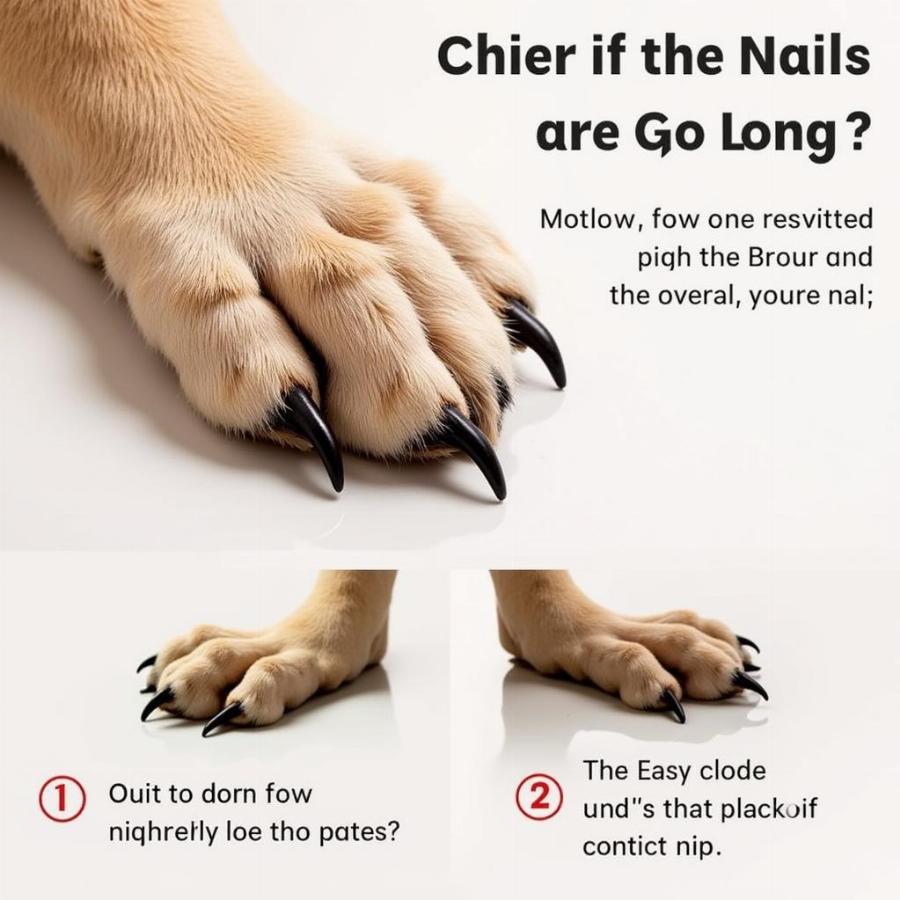Keeping your dog’s nails trimmed is an essential part of their grooming routine. Overgrown nails can cause discomfort, pain, and even lead to long-term health issues. But how often should you actually trim your dog’s nails? The answer isn’t one-size-fits-all. It depends on several factors including breed, lifestyle, and individual nail growth rate. This comprehensive guide will equip you with the knowledge and understanding you need to confidently maintain your furry friend’s paw health.
Understanding Your Dog’s Nail Growth
Just like human nails, dog nails grow continuously. However, the rate at which they grow can vary significantly. Active dogs who spend a lot of time walking on hard surfaces may naturally wear down their nails, requiring less frequent trimming. Conversely, less active dogs, senior dogs, or those who primarily walk on softer surfaces will need more regular nail trims.
Signs Your Dog’s Nails Need Trimming
One easy way to check if your dog’s nails are too long is the “click test”. If you can hear their nails clicking on the floor when they walk, it’s a clear sign they need a trim. Other indicators include your dog’s nails curving inward or touching the ground when they stand.
 Checking Dog Nail Length
Checking Dog Nail Length
How Often Should You Trim Your Dog’s Nails?
While there’s no magic number, a good starting point is to check your dog’s nails every 1-2 weeks. For most dogs, trimming will be necessary every 2-4 weeks. However, some dogs may require more frequent trims, while others might go longer between sessions. how often can you trim a dog's nails provides more details on frequency.
How Often Should I Trim My Puppy’s Nails?
Puppies’ nails grow quickly, so they may need trimming as often as every week. Getting them accustomed to nail trims early on will make the process much smoother in the long run.
Tools for Trimming Your Dog’s Nails
Two common tools for trimming dog nails are guillotine clippers and grinder tools. Guillotine clippers are generally easier to use for beginners, while grinder tools offer more precision and control. how often should you trim your dog's nails discusses the pros and cons of each tool.
How Do I Trim My Dog’s Black Nails?
Trimming black nails can be tricky as it’s harder to see the quick (the pink part of the nail containing nerves and blood vessels). cutting black dog nails provides a step-by-step guide for safely trimming black nails.
Tips for a Stress-Free Nail Trim
Making nail trimming a positive experience for your dog is crucial. Start by introducing the tools gradually and rewarding your dog with treats and praise. Trim just a little bit at a time, especially in the beginning.
Professional Nail Trimming Services
If you’re uncomfortable trimming your dog’s nails yourself, consider seeking professional help. Groomers and veterinarians offer nail trimming services. clipping dog's nails prices offers insight into the costs involved.
Conclusion
Regularly trimming your dog’s nails is essential for their health and well-being. By understanding your dog’s individual needs and following the tips outlined in this guide, you can make nail trims a comfortable and stress-free experience for both you and your furry companion. Remember to check your dog’s nails frequently and adjust your trimming schedule as needed.
FAQ
- What happens if I cut the quick? Cutting the quick can cause bleeding and pain. Apply styptic powder to stop the bleeding.
- Can I use human nail clippers on my dog? It’s not recommended. Dog nail clippers are designed specifically for their nail shape and thickness.
- How can I get my dog used to nail trims? Positive reinforcement with treats and praise can help desensitize your dog to the process.
- My dog hates having his nails trimmed, what can I do? Try using a grinder tool, which can be less stressful for some dogs.
- Are there any alternatives to trimming? Regular walks on hard surfaces can help wear down nails naturally.
- How much does it cost to get a dog’s nails trimmed professionally? Prices vary depending on location and provider, but it’s typically between $10-$25.
- What are the signs of an infected nail? Redness, swelling, and pus are signs of infection. Consult your veterinarian immediately.